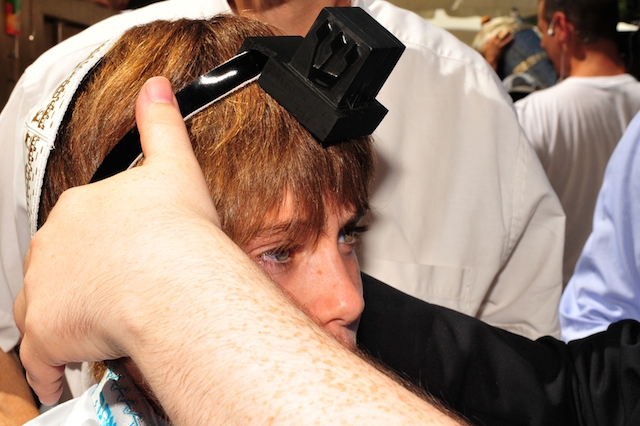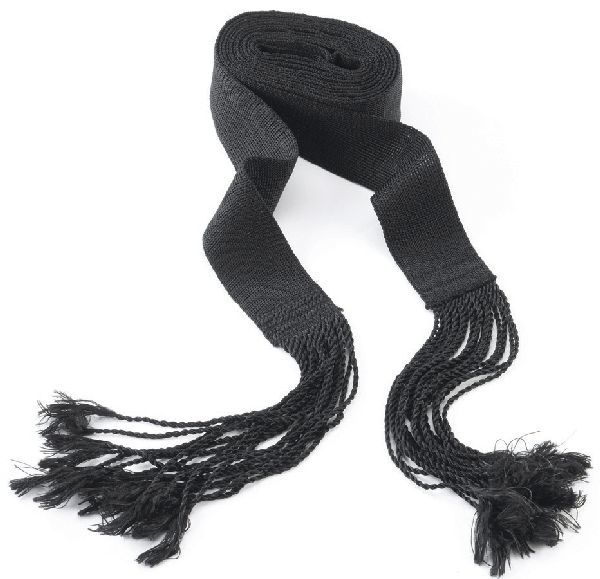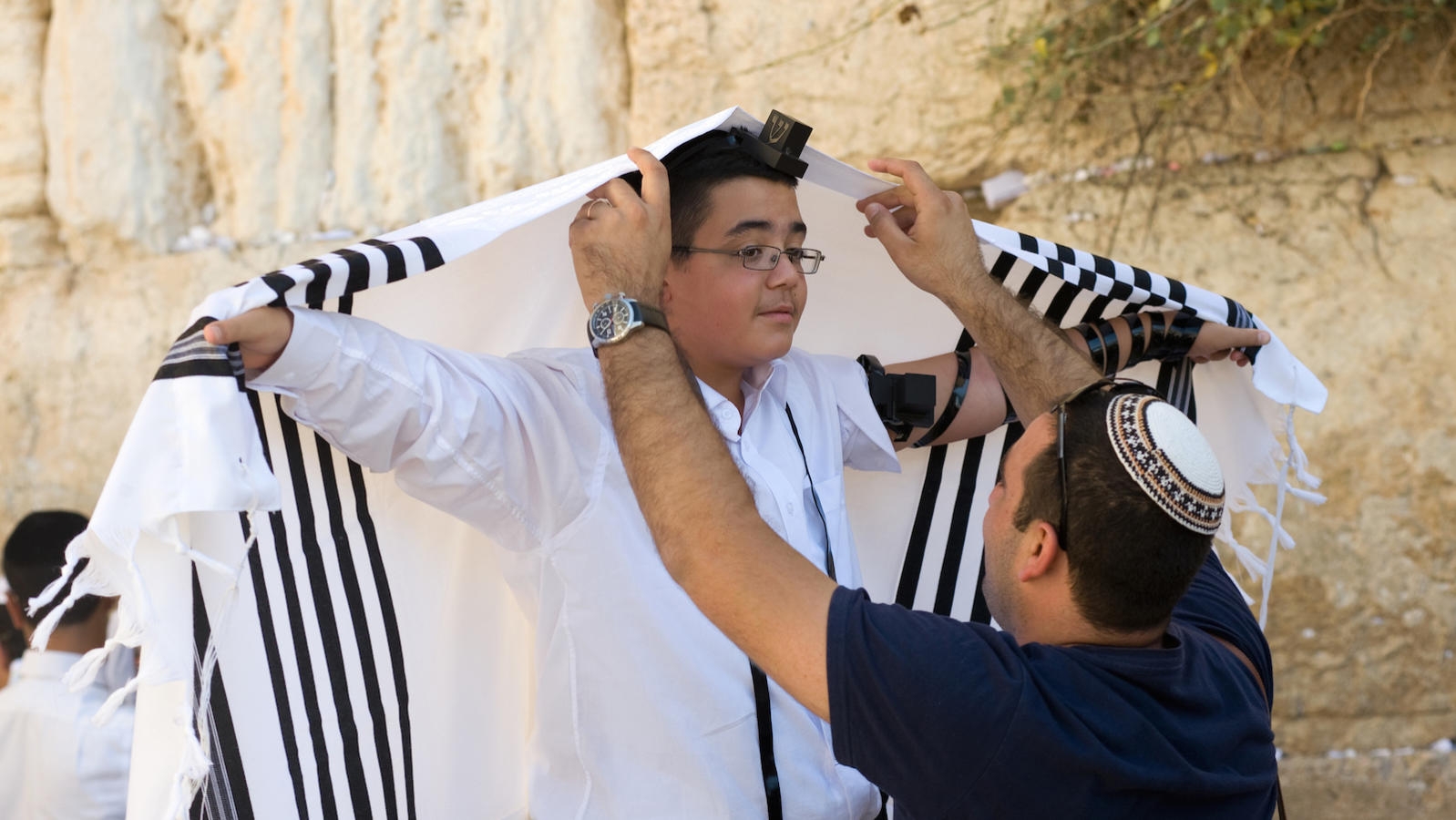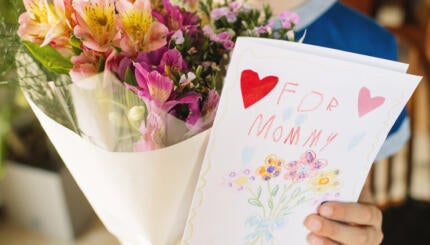Three basic items are worn during Jewish prayer: head covering, prayer shawl, and phylacteries — in Hebrew, kippah, tallit, and tefillin.
Kippah: Head Covering
The kippah (in Yiddish, yarmulke) is worn during prayer services by men, and has become optional for women as well in Reform, Conservative and Reconstructionist congregations. (In some Reform congregations, the kippah is also optional for men.) Jewish tradition does not require any specific type of head covering.
A kippah can be worn conveniently under a street hat, as was the custom of most Jews in the first half of the 20th century. It is still the practice of many Orthodox Jewish men to wear a head covering throughout the day, not just during prayer. (One tradition holds that a Jewish man should not walk more than four cubits in any direction with an uncovered head.)
Tallit: Prayer Shawl
The tallit is a large rectangular shawl made of wool, cotton or synthetic fibers. In each of the four corners of the shawl are strings tied in a particular pattern, called tzitzit. The origin of the tzitzit is biblical; the practice is prescribed in Numbers 15. The precept is to put these strings on the four corners of one’s garment — in ancient tradition, with a single strand of blue as well–as a reminder of the duties and obligations of a Jew. Since we no longer wear four-cornered garments, the tallit is worn specifically to fulfill the biblical precept.
With your help, My Jewish Learning can provide endless opportunities for learning, connection and discovery.
Traditionally, men wear a tallit during morning services; in non-Orthodox synagogues, many women also wear a tallit. In some Orthodox congregations, only married men wear a tallit. One may see people gathering the tzitzit in their left hand and kissing them when the paragraph from the Torah referring to them is recited.
Tefillin: Phylacteries

The tefillin consist of two black leather boxes and straps to hold them on. One is worn on the biceps, and its strap, which is tied with a special knot, is wound by the wearer seven times around the forearm and hand—on the left arm for right-handed people and on the right for those who are left-handed. The second box is worn on the forehead at the hairline, with its straps going around the back of the head, connected at the top of the neck with a special knot, and hanging in front on each side.
Four passages in the Torah call upon the Israelites to keep God’s words in mind by “bind[ing] them as a sign upon [their] hands and making them totafot [an enigmatic term] between [their] eyes.” Tefillin, as ordained by the rabbinic leaders of classical Judaism, are intended to fulfill that commandment.
The tefillin are worn during morning services except on Shabbat or festivals. Most men wear tefillin in Orthodox and Conservative congregations, as do some women in Conservative congregations. The use of tefillin is less prominent in Reform and Reconstructionist congregations by both men and women. Inside the tefillin are handwritten parchments with texts from the four passages mentioned above.
Gartel

Some men in Hasidic communities wear a cloth belt, called a gartel, during prayer. Some take it as a symbol of “girding one’s loins with strength” — a potent biblical image.
The use of special garments for prayer is full of historic and contemporary symbolism. One envelops oneself in the tallit, creating a private space for prayer and meditation in the midst of the larger congregation, its tzitzit providing a reminder of one’s duties and obligations as a Jew. The binding of the arm and the head with tefillin reminds the wearer to use her or his physical and mental powers for the service of God throughout the day, controlling action and thought in order to bring blessing to others and self. Jewish men have been wearing these items for more than two millennia, and so they are a powerful symbol of continuity over time.
bar mitzvah
Pronounced: bar MITZ-vuh, also bar meetz-VAH, Origin: Hebrew, Jewish rite of passage for a 13-year-old boy.
kippah
Pronounced: KEE-pah or kee-PAH, Origin: Hebrew, a small hat or head covering that Orthodox Jewish men wear every day, and that other Jews wear when studying, praying or entering a sacred space. Also known as a yarmulke.
mitzvah
Pronounced: MITZ-vuh or meetz-VAH, Origin: Hebrew, commandment, also used to mean good deed.
tallit
Pronounced: tah-LEET or TAH-liss, Origin: Hebrew, prayer shawl.
tefillin
Pronounced: tuh-FILL-in (short i in both fill and in), Origin: Hebrew, phylacteries. These are the small boxes containing the words of the Shema that are traditionally wrapped around one's head and arm during morning prayers.
Torah
Pronunced: TORE-uh, Origin: Hebrew, the Five Books of Moses.
tzitzit
Pronounced: TZEET-tzeet, or TZIT-siss, Origin: Hebrew, fringes tied to the corners of a prayer shawl.



